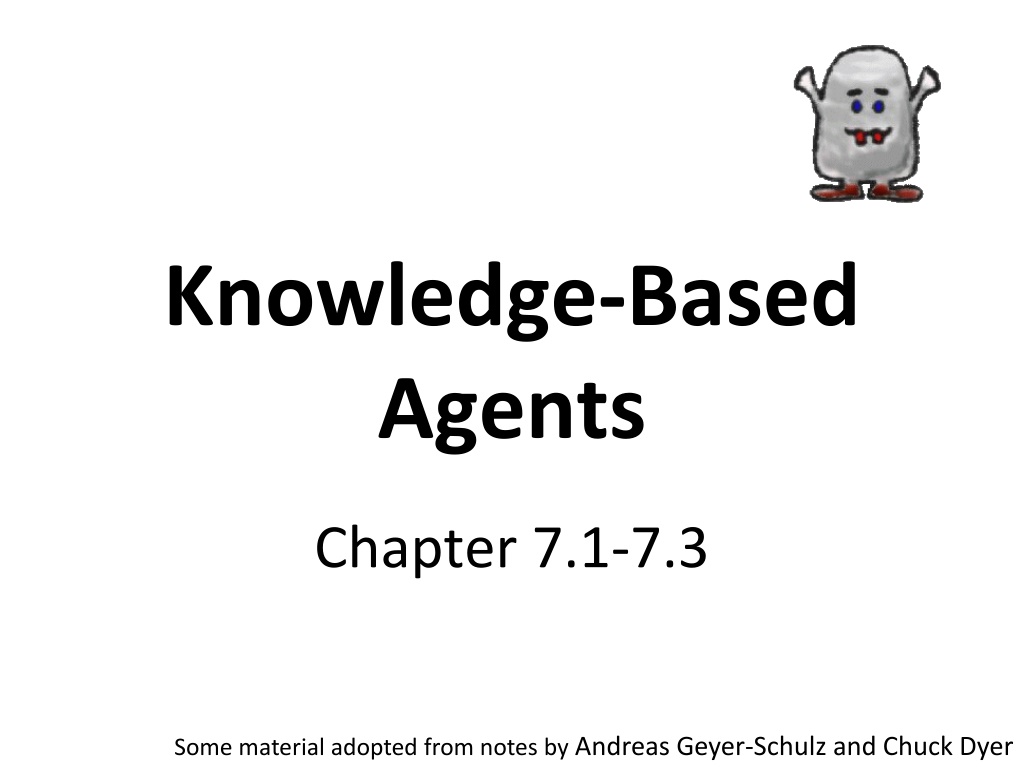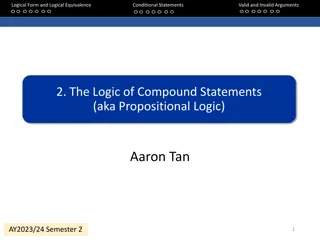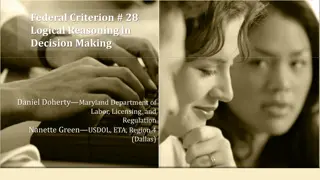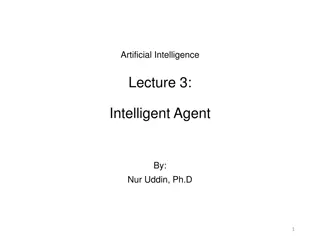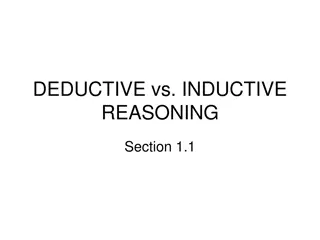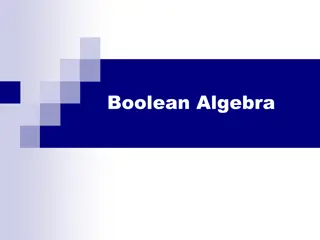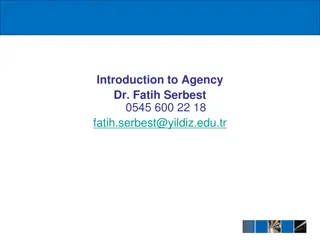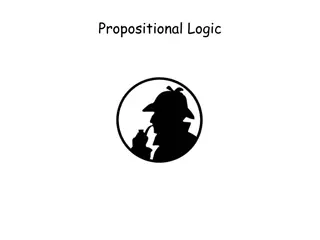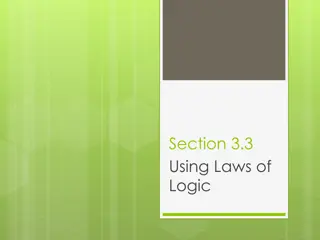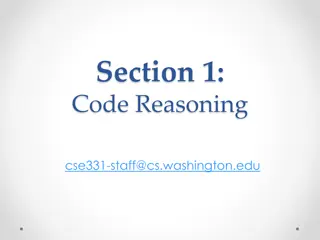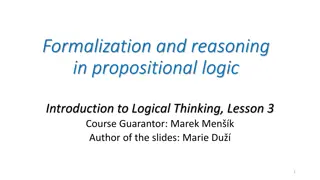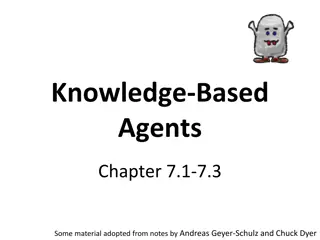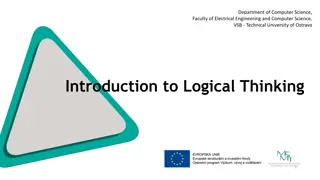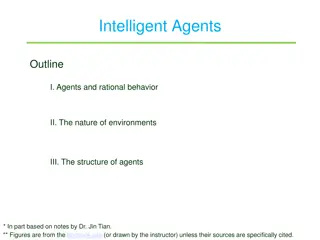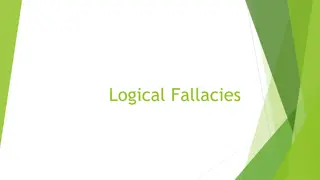Understanding Knowledge-Based Agents and Logical Reasoning
Knowledge-based agents utilize logic for problem-solving, drawing conclusions from data. People employ various reasoning strategies, including fast and slow thinking processes. Explore the application of logic in inference and decision-making, as well as the challenges of human logical reasoning.
Download Presentation

Please find below an Image/Link to download the presentation.
The content on the website is provided AS IS for your information and personal use only. It may not be sold, licensed, or shared on other websites without obtaining consent from the author. Download presentation by click this link. If you encounter any issues during the download, it is possible that the publisher has removed the file from their server.
E N D
Presentation Transcript
Knowledge-Based Agents Chapter 7.1-7.3 Some material adopted from notes by Andreas Geyer-Schulz and Chuck Dyer
Big Idea Drawing reasonable conclusions from a set of data (observations, beliefs, etc.) seems key to intelligence Logic is a powerful and well-developed approach to this & highly regarded by people Logic is also a strong formal system that computers can use (cf. John McCarthy s work) We can solve some AI problems by represent- ing them in logic and applying standard proof techniques to generate solutions
Inference in People People can do logical inference, but are not always very good at it Reasoning with negation and disjunction seems particularly difficult But people seem to employ many kinds of reasoning strategies, most of which are neither complete nor sound 3
Thinking Fast and Slow A popular 2011 book by a Nobel prize winning author His model is we have two different types of reasoning facilities System 1 operates automatically and quickly, with little or no effort and no sense of voluntary control System 2 allocates attention to effortful mental activities that demand it, including complex computations (e.g., logic, arithmetic, writing software, etc.)
Question #1 Here is a simple puzzle Don t try to solve it -- listen to your intuition and type an answer into the chat
Question #1 Here is a simple puzzle Don t try to solve it -- listen to your intuition and type an answer into the chat A bat and ball cost $1.10 The bat costs one dollar more than the ball How much does the ball cost?
Question #1 Here is a simple puzzle Don t try to solve it -- listen to your intuition and type an answer into the chat A bat and ball cost $1.10 The bat costs one dollar more than the ball How much does the ball cost? The ball costs $0.05
Question #2 Try to determine, as quickly as you can, if the argument is logically valid. Does the conclusion follow the premises?
Question #2 Try to determine, as quickly as you can, if the argument is logically valid. Does the conclusion follow the premises? All roses are flowers Some flowers fade quickly Therefore, some roses fade quickly
Question #2 Try to determine, as quickly as you can, if the argument is logically valid. Does the conclusion follow the premises? All roses are flowers Some flowers fade quickly Therefore, some roses fade quickly It is possible that there are no roses among the flowers that fade quickly
Question #2 Try to determine, as quickly as you can, if the argument is logically valid. Does the conclusion follow the premises? Flowers All roses are flowers Some flowers fade quickly Therefore, some roses fade quickly quick roses faders It is possible that there are no roses among the flowers that fade quickly
Question #3 It takes 5 machines 5 minutes to make 5 widgets How long would it take 100 machines to make 100 widgets?
Question #3 It takes 5 machines 5 minutes to make 5 widgets How long would it take 100 machines to make 100 widgets? 100 minutes or 5 minutes?
Question #3 It takes 5 machines 5 minutes to make 5 widgets How long would it take 100 machines to make 100 widgets? 100 minutes or 5 minutes? 5 minutes
Wason Selection Task I have a pack of cards; each has a letter written on one side and a number on the other I claim the following rule is true: If a card has a vowel on one side, then it has an even number on the other Which cards should you turn over in order to decide whether the rule is true or false? E 4 T 7 Wikipedia
Wason Selection Task Wason (1966) showed people are bad at this task To disprove rule P=>Q, find a situation in which P is true but Q is false, i.e., show P^~Q To disprove vowel => even, find a card with a vowel and an odd number Thus, turn over the cards showing vowels and those showing odd numbers E 4 T 7
Wason Selection Task This version is easier for people, as shown by Griggs & Cox, 1982 You are the bouncer in a bar; which of these people do you card given the rule: You must be 21 or older to drink beer. beer coke 22 20
Wason Selection Task This version is easier for people, as shown by Griggs & Cox, 1982 You are the bouncer in a bar; which of these people do you card given the rule: You must be 21 or older to drink beer. beer coke 22 20 Perhaps easier because it s more familiar or because people have special strategies to reason about certain situations, such as cheating in a social situation
Negation in Natural Language We often model the meaning of natural language sentences as a logic statements This maps these into equivalent statements All elephants are gray No elephant are not gray Double negation is common in informal language: that won t do you no good As a way to state a negative more strongly
Negation in Natural Language It s not just informal language actually What does this mean: we cannot underestimate the importance of logic Does is mean logic is important or not? See the LanguageLog blog misnegation archive for lots of real-world examples
Logic as a Methodology Even if people don t use formal logical reason- ing for solving a problem, logic might be a good approach for AI for many reasons Airplanes don t need to flap their wings Logic may be a good implementation strategy Solution in a formal system offers other benefits, e.g., letting us prove properties of the approach See neats vs. scruffies
Knowledge-based agents Knowledge-based agents have a knowledge base (KB) and an inference system KB: a set of representations of facts believed true Each individual representation is called a sentence Sentences are expressed in a knowledge represent- ation language The agent operates as follows: 1. It TELLs the KB what it perceives 2. It ASKs the KB what action it should perform 3. It performs the chosen action
Architecture of a KB agent Knowledge Level Most abstract: describe agent by what it knows Ex: Autonomous vehicle knows Golden Gate Bridge connects San Francisco with the Marin County Logical Level Level where knowledge is encoded into sentences Ex: links(GoldenGateBridge, SanFran, MarinCounty) Implementation Level Software representation of sentences, e.g. (links,goldengatebridge,sanfran,marincounty)
Wumpus World environment Based on Hunt the Wumpus computer game from 1972 Agent explores cave of rooms connected by passageways Lurking in a room is the Wumpus, a beast that eats any agent that enters its room Some rooms have bottomless pits that trap any agent that wanders into the room Somewhere is a heap of gold in a room Goal: collect gold & exit w/o being eaten
AIMAs Wumpus World The agent always starts in the field [1,1] Agent s task is to find the gold, return to the field [1,1] and climb out of the cave
Agent in a Wumpus world: Percepts The agent perceives stench in square containing Wumpus and in adjacent squares (not diagonally) breeze in squares adjacent to a pit glitter in the square where the gold is bump, if it walks into a wall Woeful scream everywhere in cave, if Wumpus killed Percepts given as five-tuple, e.g., if stench and breeze, but no glitter, bump or scream: (Stench, Breeze, None, None, None) Agent cannot perceive its location, e.g., (2,2)
Wumpus World Actions go forward turn right 90 degrees turn left 90 degrees grab: Pick up object in same square as agent shoot: Fire arrow in direction agent faces. It continues until it hits & kills Wumpus or hits outer wall. Agent has one arrow, so only first shoot action has effect climb: leave cave, only effective in start square die: automatically and irretrievably happens if agent enters square with pit or living Wumpus
Wumpus World Goal Agent s goal is to find the gold and bring it back to the start square as quickly as possible, without getting killed 1,000 point reward for climbing out of cave with gold 1 point deducted for every action taken 10,000 point penalty for getting killed
AIMAs Wumpus World The agent always starts in the field [1,1] Agent s task is to find the gold, return to the field [1,1] and climb out of the cave
Exploring a wumpus world label fact A agent B breeze G glitter OK safe cell P pit S stench W wumpus We label cells with facts agent learns about them as it moves through world
The Hunters first step W W Since agent is alive and perceives neither breeze nor stench at (1,1), it knows (1,1) and its neighbors are OK Moving to (2,1) is a safe move that reveals a breeze but no stench, implying that Wumpus isn t adjacent but one or more pits are
Exploring a wumpus world A B G OK safe cell P pit S stench W wumpus agent breeze glitter Let s start over and assume the agent moves to (1,2) and detects a Breeze. A pit must be in (1,3) or (2,2). What should the agent do next?
Exploring a wumpus world A B G OK safe cell P pit S stench W wumpus agent breeze glitter Returning to (1,1), and then going to (2,1) is a safe move. Always prefer a safe move to a risky one. If the agent perceives a stench but no breeze in (2,1), what can it conclude?
Exploring a wumpus world A B G OK safe cell P pit S stench W wumpus agent breeze glitter No stench in (1,2) => Wumpus not in (2,2) => Wumpus in (1,3) No breeze in (2,1) => no pit in (2,2) => pit in (1,3)
Exploring a wumpus world A B G OK safe cell P pit S stench W wumpus agent breeze glitter The agent goes to (2,2) since it s safe
Exploring a wumpus world A B G OK safe cell P pit S stench W wumpus agent breeze glitter Detecting neither a stench or breeze means that (2,3) and (3,2) are safe
Exploring a wumpus world A B G OK safe cell P pit S stench W wumpus agent breeze glitter We pick one of the safe moves, (2,3), and detect a breeze, stench and glitter.
Exploring a wumpus world A B G OK safe cell P pit S stench W wumpus agent breeze glitter P? P? Found gold! Now it must find way back to (1,1). Hopefully, it has been remembering it s moves so can quickly return to (1,1) via safe moves
Logic in general Logics are formal languages for representing information so that conclusions can be drawn Syntax defines the sentences in the language Semantics define the "meaning" of sentences i.e., define truth of a sentence in a world E.g., the language of arithmetic x+2 y is a sentence; x2+y > {} is not a sentence x+2 y is true iff the number x+2 is no less than the number y x+2 y is true in a world where x = 7, y = 1 x+2 y is false in a world where x = 0, y = 6 x+1> x is true for all numbers x
Entailment Entailment: one thing follows from another KB Knowledge base KBentails sentence iff is true in all possible worlds where KB is true A possible world where KB is true can contain additional facts as long as they don t contradict anything in the KB E.g.: what we know today + there s lif on Venus!
Entailment Entailment: one thing follows from another KB Knowledge base KBentails sentence iff is true in all possible worlds where KB is true E.g., the KB containing UMBC won and JHU won entails Either UMBC won or JHU won E.g., x+y = 4 entails x = 4 - y Entailment is a relationship between (sets of) sentences (i.e., syntax) that is based on semantics
Models Logicians talk of models: formally structured worlds w.r.t which truth can be evaluated m is a model of sentence if is true in m Lots of other things might or might not be true or might be unknown in m M( ) is the set of all models of Then KB iff M(KB) M( ) KB = UMBC and JHU won = UMBC won Then KB
Entailment in the Wumpus World Situation after detecting nothing in [1,1], move right, breeze in [2,1] Possible models for KB assuming only pits and restricting cells to {(1,3)(2,1)(2,2)} Two observations: ~B11, B12 Three more propositional variables variables: P13, P21, P22 8 possible models consistent with observations 4 3 2 1 1 3 4 2 B11: breeze in (1,1) P13: pit in (1,3)
Wumpus models P13 P21 P22 F F F F F T F T F F T T T F F T F T T T F T T T Each row is a possible world Some of these are inconsistent with the observed facts
Wumpus World Rules (1) If a cell has a pit, then a breeze is observable in every adjacent cell In propositional calculus we can not have rules with variables (e.g., forall X ) P11 => B21 P11 => B12 P21 => B11 P21 => B22 these also follow ~B21 => ~P11 ~B12 => ~P11 ~B11 => ~P21 ~B22 => ~P21 If a pit in (1,1) then a breeze in (2,1),
Only three of the possible models are consistent with what we know Wumpus models Any of the three might be the way the world really is KB = wumpus-world rules + observations
Wumpus World Rules (2) Cell safe if it has neither a pit nor wumpus OK11 => ~P11 ~W11 OK12 => ~P12 ~W12 From which we can derive the more useful rules P11 W11 => ~OK11 P11 => ~OK11 W11 => ~OK11 OK11: (1,1) is safe W11: Wumpus in (1,1)
Wumpus models KB = wumpus-world rules + observations
Wumpus models KB = wumpus-world rules + observations 1 = [1,2] is safe Since all models include 1 KB 1, proved by model checking
